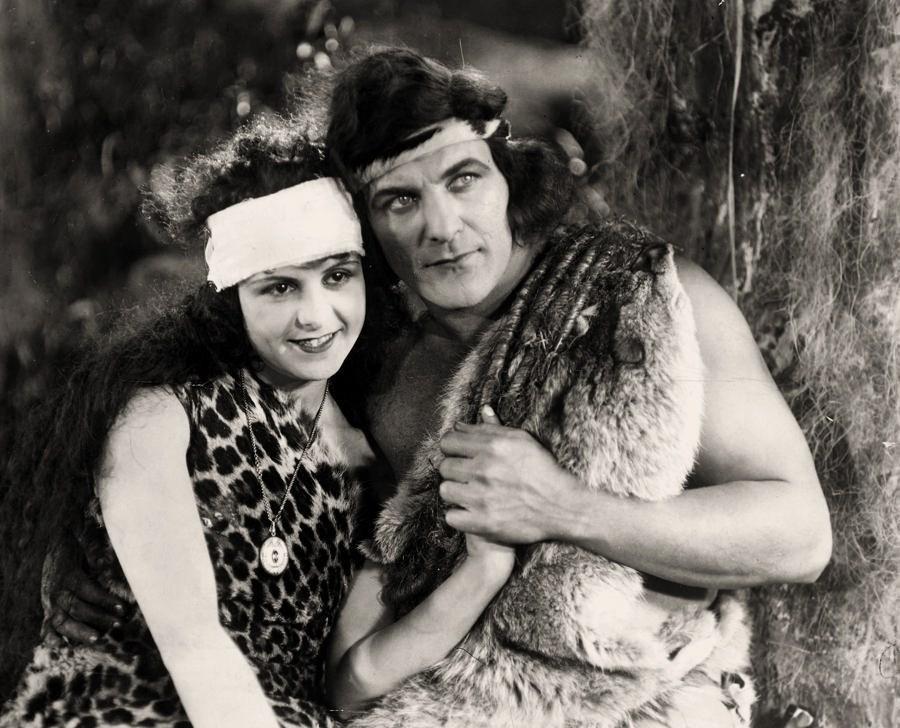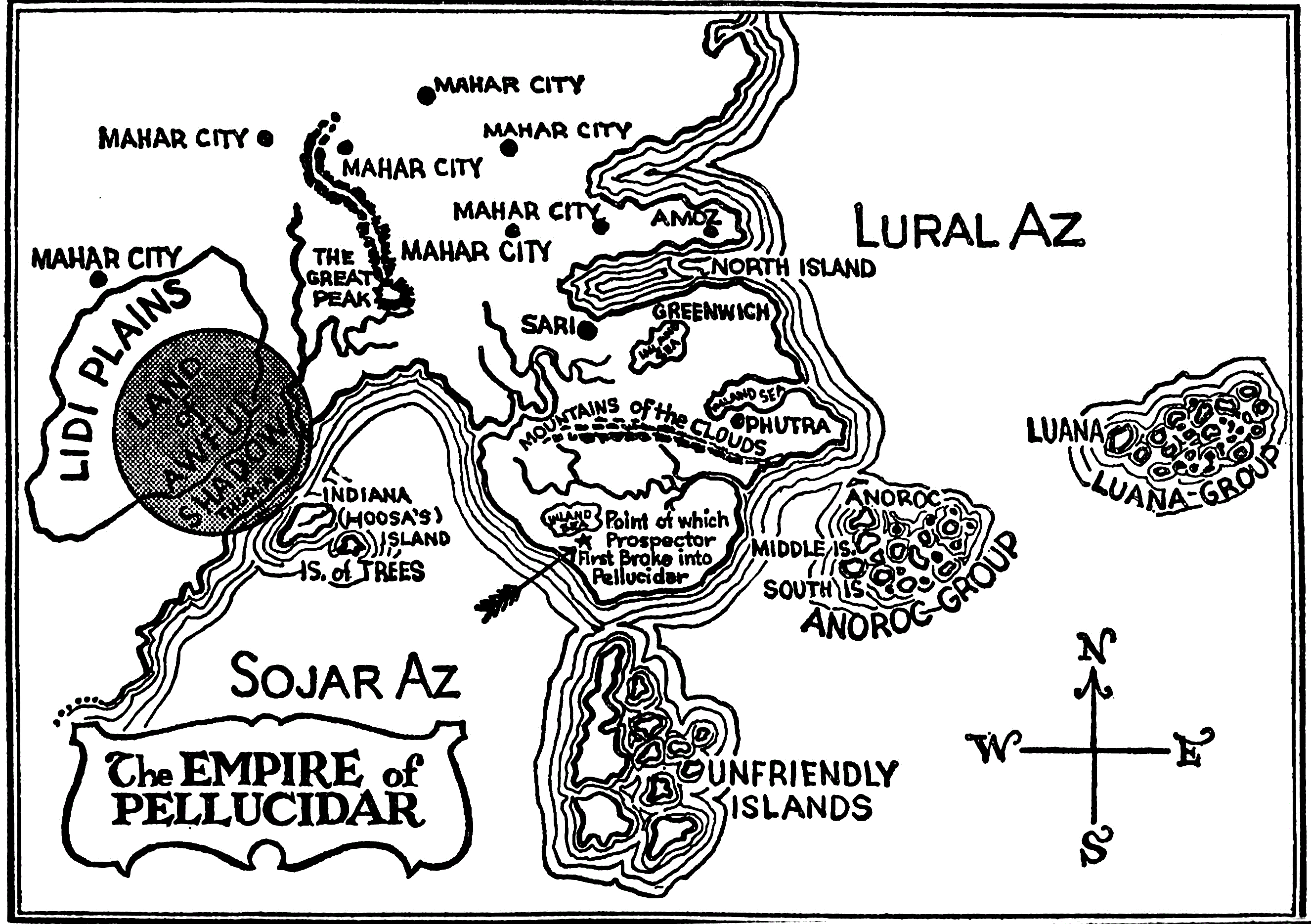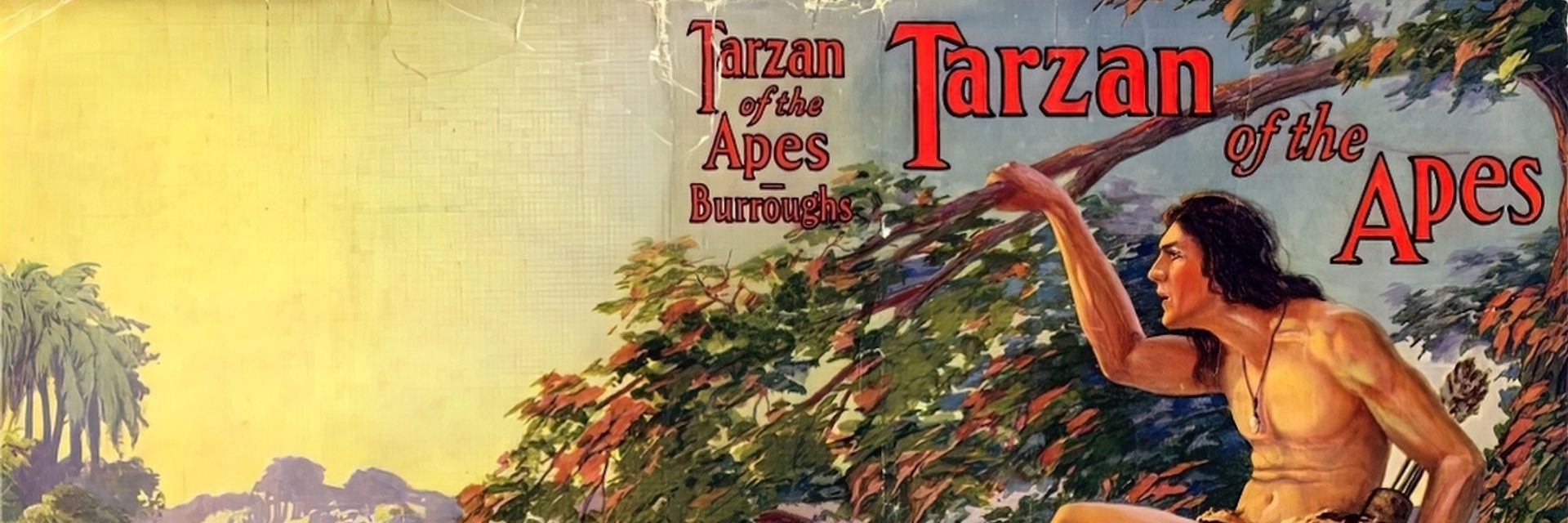After years of professional failure, with a wife and two young children to support, Edgar Rice Burroughs started writing, and soon created Tarzan, one of the most famous characters in popular fiction. His business background led Burroughs to become the first author to incorporate. Licensing rights to his creations brought a huge income he spent on a lavish Hollywood lifestyle. But churning out dozens of adventure novels led to a creative decline. The implicit racism behind his work has also diminished its value. But if much of Burroughs’s fiction is dated, he was a master at world-building, adding realistic details to fantastic tales. And Tarzan still lives, now representing a human connection to endangered species and wild places under attack.
◊
By 1911, 36-year-old Ed Burroughs had reached a dead end.
His early life had more than its share of excitement. A stint in the U.S. Cavalry, chasing Apache “renegades” in the desert Southwest, was followed by a few years cowboy-ing on his brother’s Idaho ranch. After that, he was a gold prospector, then a railroad policeman.
Desiring something better in life, he returned to his native Chicago, where his father, a Civil War hero and successful businessman, helped him find the first of a series of white-collar jobs. Chief among these was a year spent as head of the stenography department of Sears, Roebuck and Company. There he oversaw 150 secretaries who turned out an estimated 4,000 letters a day for the colossal mail-order company.
Wanting to make his own mark, Burroughs quit Sears for a partnership in an ad agency that soon went under. After that came a stint as a salesman for a pencil sharpener company, then years as the low-paid editor of a magazine for small businesses.
Married to his high school sweetheart, with two young children, Burroughs began writing at night. He enjoyed spinning imaginative tales for his kids, and decided to create something for the cheap pulp magazines then gaining in popularity. “I remember thinking,” he told an interviewer years later, “that if other people got money for writing such stuff I might, too, for I was sure I could write stories just as rotten as theirs.”
In about two months he finished a short fantasy novel, Under the Moons of Mars, and sent it to Argosy magazine. He was embarrassed enough by the work to submit it under a pseudonym, Normal Bean. The adventure story of an American soldier magically transported to the Red Planet (much like how Mark Twain’s Connecticut Yankee traveled to King Arthur’s court) was bought for $400. Check deposited, Ed Burroughs did not look back.
A medieval adventure romance quickly followed. It was turned down by the editor of All-Story magazine, who nevertheless warmly encouraged him to keep at it. His next short novel, 1912’s Tarzan of the Apes, was accepted enthusiastically and published under his full name, Edgar Rice Burroughs, in a single issue of the magazine. It profoundly changed his life, along with popular culture, and the pop culture business, forever.
“Me, Tarzan,” the First Superhero
The orphaned infant child of marooned English aristocrats, Tarzan was adopted and named by a troop of advanced apes in the wilds of Africa, growing into an action hero. The novel was an overnight sensation. Its debut in All-Story led to newspaper serialization and a hardcover book the following year.
Fast-paced, imaginative, and ably told, Tarzan borrows from sources as diverse as Rudyard Kipling’s The Jungle Book (1892), whose main character Mowgli was a boy raised by wolves; the jungle adventure tales of H. Rider Haggard; and even Joseph Conrad, from whom Burroughs took the As-Told-to-Me narrative frame of the 1906 classic novella, Heart of Darkness.
With his overnight success, Burroughs was able to draw on his hard-earned corporate savvy. Affable and easy-going, he considered himself a storyteller, not a writer, whose job was to steadily produce product that was then sold to the highest bidder.
In 1914, with Tarzan’s success making him the most famous author in America, Burroughs bought a large house in the Chicago suburb of Oak Park. This almost certainly made an impression on 15-year-old Ernest Hemingway, who lived just eight blocks away.
Burroughs was the first writer to incorporate as a business – ERB Inc. – that licensed all of his characters and stories. In the early stages of his career, this mainly meant serial publication rights, magazines, newspapers, and hardcover editions of the novels that began to flow from his pen. His foresight, though, created a goldmine in 1918 when the first Tarzan film debuted.

Jane and Tarzan, 1918, as played by Enid Markey and Elmo Lincoln. (Image credit: Wikimedia Commons)
Though the first movie Tarzan, Elmo Lincoln, looked more like a weightlifter in a long, furry, off-the-shoulder gown, and not the lithe, nearly nude character of the novel, the film was an immediate smash. With then-groundbreaking special effects, and relatively realistic jungle scenes, it was one of the first films to gross more than $1 million. Burroughs’s share was a cool $45,000 (over $800,000 in 2021 dollars).
Tarzan Kick-Starts Action Hero Movies
Tarzan was the first superhero to appear across a range of consumer products – candy, games, toys, comic strips, comic books, radio shows, and films. Fourteen years after the first movie, Tarzan was back in theaters, now in the shape of Olympic swimming champion Johnny Weissmuller, exactly the trim and muscular figure Burroughs envisioned for his famous character.
The first two MGM Tarzan films were particularly notable for Weissmuller’s jungle yell, ever after associated with the character, and the sexy chemistry between him and costar Maureen O’Sullivan, Tarzan’s “mate” Jane.
Made before the Hays production code enforced a nearly Victorian modesty on Hollywood movies, Tarzan the Ape Man (1932) and Tarzan and His Mate (1934) dressed their two gorgeous stars in the skimpiest outfits possible at the time. The second film even included a beautifully shot nude underwater ballet. Cut from the finished film, it was rediscovered in MGM’s archives decades later.
But if the ten next Weissmuller movies earned Burroughs another fortune, they also took Tarzan away from him. The plots for the films were cobbled together by studio writers, and drifted widely from the characters and stories Burroughs continued to produce.
Where Weissmuller’s Tarzan spoke in a pidgin English, and rarely left the jungle home he shared with Jane and their adopted son “Boy,” the Tarzan of the novels (human name: John, Lord Greystoke) had quickly regained the status and estate of his aristocratic parents, learned to fly airplanes, dressed well, could speak French, and lived with Jane (and their biological son Jack) on an enormous African ranch, returning to his jungle ways only as needed by the demands of plot.
Widely considered the best-selling American author of the first half of the 20th century, Burroughs’s dozens of adventure titles are estimated to have sold as many as 60 million copies.
Burroughs admitted that “most of the stories I wrote were the stories I told myself before I went to sleep.” As such, they are particular tales of wish fulfillment of a long-frustrated, white American man who grew up in the late 19th century. Burroughs, according to the novelist and critic Gore Vidal, “consoled himself with an inner world where he was strong and handsome, adored by beautiful women and worshipped by exotic races.” Consequently, his stories can present problems for many contemporary readers.
Though his cavalry experience left Burroughs with a respect for the black soldiers he served with, and an admiration of the Native Americans he encountered on duty, as he aged, and his writing became more formulaic, common racist tropes of savage Africans, and stereotypically comic Afro-American servants, infused his stories.
White supremacy – based explicitly on culture, not genetics – is the now-obvious subtext of the Tarzan and Mars adventures. Burroughs’s worst racial animus, however, was directed at the Japanese. In his last Tarzan novel, Tarzan and the Foreign Legion, written in 1943, Tarzan, helped by a drug giving him eternal youth, shows up to fight for the Allies in the South Pacific.
Tarzan and the Demands of the Market
Burroughs escaped a financial dead end by writing Tarzan of the Apes, but churning out a stream of pulp novels with the same characters, year in and out, for two decades eventually brought on a creative one.
He was never too fussy about how his stories unfolded. The later works in the Tarzan (24 novels total) and Mars (10 books) series, along with a third series, six titles total, about the Land of Pellucidar, a prehistoric world inside a hollow Earth, rely on stock predicaments, outlandish coincidences, and bad dialogue.
The decline in quality was the direct result of a constant need for new product. For all the money Burroughs made, he spent it on a millionaire’s lifestyle once he moved from Oak Park to Los Angeles in 1918.
In 1918, Burroughs bought the 550-acre San Fernando Valley mansion estate of the late newspaper publisher H.G. Otis, naming his new home for his famous hero. Tight finances forced Burroughs to subdivide and sell the property, for a neat profit, six years later. In doing so he created the Los Angeles neighborhood still called Tarzana.
In California, he settled into a life of steady writing (producing many action novels outside the three fantasy adventure series) and business deals. A divorce and quick remarriage to a woman half his age preceded a move to Honolulu in 1936. There he witnessed the December 1941 attack on Pearl Harbor. A two-year stint as a celebrity war correspondent, without seeing much action, in the Pacific brought a level of thrills missing from his life since his cavalry/cowboy days.
By then, though, Burroughs was suffering from decades of heavy cigarette smoking and vigorous social drinking. Divorced again, and increasingly incapacitated with a failing heart, he died of a coronary in Los Angeles in 1950. ERB Inc., however, continued to run, managed by his son and grandson, and still licenses products to this day.
Why Tarzan Matters
Given the poor quality of Burroughs’ later stories, and the tacit racism of so many of the tales, is his work still worth reading? In spite of those liabilities, Edgar Rice Burroughs did a lot of stuff right. He took great pride in researching details for his African stories, and created maps and languages for his make-believe realms.

A map of the world found inside a hollow Earth, drawn by Burroughs, from the first hardcover edition of Pellucidar.
(Source: Wikimedia Commons)
He was a genius at what’s now called world-building, hanging his fantasies on a frame of realistic details. He came up with some excellent names, and was peerless at describing action – everything from sword fights to horseback riding. Most of all, he had a rich imagination that makes his best works, none of them very long, fun to read.
What’s more, Burroughs’s immense popularity gave an early drive and distinction to pulp fiction, that very American literary form, and by doing so inspired generations of young writers. And if his prose can’t compare with the work of the best pulp authors, his characters certainly do.
Tarzan, like any mythic being, has survived for more than a century in the popular imagination by representing wide and ongoing cultural concerns. Once standing for a certain kind of European management of wild places and remote people, Tarzan now represents an immersive encounter with nature, a vivid connection between humans and animals that recognizes our shared existence on the planet, and the threat to endangered species and pristine landscapes.
Tarzan as Eco-Warrior? It’s a safe bet that Ed Burroughs, were he alive today, would be happy to tell that story.
Ω
Title Image: From the dust jacket of an early edition of Tarzan of the Apes. (Source: erbzine.com)

